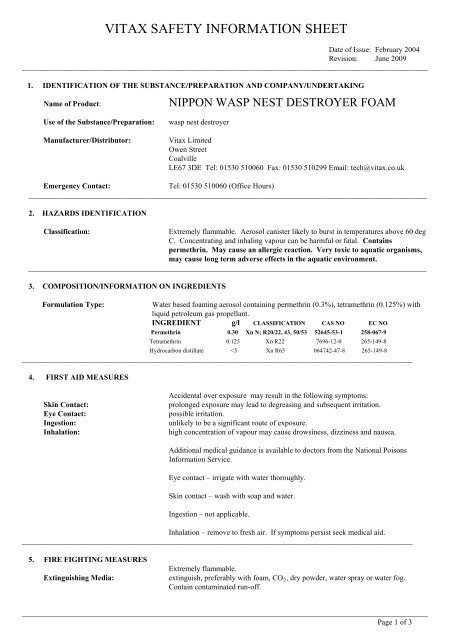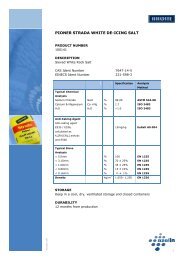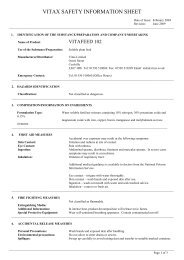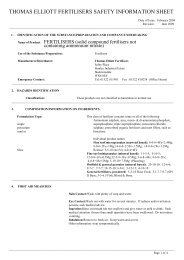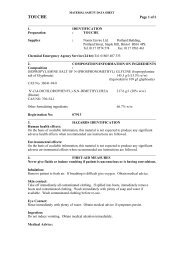VITAX SAFETY INFORMATION SHEET
Nippon Wasp Nest Destroyer Foam - Collier Turf Care Ltd
Nippon Wasp Nest Destroyer Foam - Collier Turf Care Ltd
- No tags were found...
Create successful ePaper yourself
Turn your PDF publications into a flip-book with our unique Google optimized e-Paper software.
<strong>VITAX</strong> <strong>SAFETY</strong> <strong>INFORMATION</strong> <strong>SHEET</strong><br />
Date of Issue: February 2004<br />
Revision: June 2009<br />
__________________________________________________________________________________________________________<br />
1. IDENTIFICATION OF THE SUBSTANCE/PREPARATION AND COMPANY/UNDERTAKING<br />
Name of Product:<br />
NIPPON WASP NEST DESTROYER FOAM<br />
Use of the Substance/Preparation:<br />
Manufacturer/Distributor:<br />
wasp nest destroyer<br />
Vitax Limited<br />
Owen Street<br />
Coalville<br />
LE67 3DE Tel: 01530 510060 Fax: 01530 510299 Email: tech@vitax.co.uk<br />
Emergency Contact:<br />
Tel: 01530 510060 (Office Hours)<br />
________________________________________________________________________________________________________<br />
2. HAZARDS IDENTIFICATION<br />
Classification:<br />
Extremely flammable. Aerosol canister likely to burst in temperatures above 60 deg<br />
C. Concentrating and inhaling vapour can be harmful or fatal. Contains<br />
permethrin. May cause an allergic reaction. Very toxic to aquatic organisms,<br />
may cause long term adverse effects in the aquatic environment.<br />
________________________________________________________________________________________________________<br />
3. COMPOSITION/<strong>INFORMATION</strong> ON INGREDIENTS<br />
Formulation Type:<br />
Water based foaming aerosol containing permethrin (0.3%), tetramethrin (0.125%) with<br />
liquid petroleum gas propellant.<br />
INGREDIENT g/l CLASSIFICATION CAS NO EC NO<br />
Permethrin 0.30 Xn N; R20/22, 43, 50/53 52645-53-1 258-067-9<br />
Tetramethrin 0.125 Xn R22 7696-12-0 265-149-8<br />
Hydrocarbon distillate
<strong>VITAX</strong> <strong>SAFETY</strong> <strong>INFORMATION</strong> <strong>SHEET</strong><br />
Date of Issue: February 2004<br />
Revision: June 2009<br />
__________________________________________________________________________________________________________<br />
Additional Information:<br />
under intense heat, product decomposition may release nitrogen and carbon<br />
dioxides. Aerosol canister liable to burst in temperatures above 60 deg C.<br />
Special Protective Equipment: wear self-contained breathing apparatus and suitable protective clothing in confined<br />
spaces.<br />
________________________________________________________________________________________________________<br />
6. ACCIDENTAL RELEASE MEASURES<br />
Personal Precautions:<br />
do not eat, drink or smoke. Wash hands and exposed skin after handling.<br />
Environmental precautions: report to local water plc immediately if spillage enters drains and the Environment<br />
Agency or Scottish Environment Protection Agency if it enters surface or ground<br />
waters. Keep away from sources of ignition. Ensure adequate ventilation.<br />
Spillages:<br />
soak up with absorbent material such as sand, transfer to suitable marked container<br />
and keep safe before disposal.<br />
________________________________________________________________________________________________________<br />
7. HANDLING & STORAGE<br />
Handling:<br />
pressurised container: protect from sunlight and do not expose to temperatures<br />
exceeding 50 deg C. Do not pierce or burn after use. Do not block stack pallets.<br />
Storage:<br />
store in original containers, tightly closed in a secure, well ventilated, cool but frostfree,<br />
dry area. Store clear of foodstuffs. Make arrangements for containment of<br />
accidental spillage. Keep away from sources of ignition – no smoking. Keep out of<br />
reach of children.<br />
_________________________________________________________________________________________________________<br />
8. EXPOSURE CONTROLS/ see regulatory information for details of occupational exposure standards (EH40). No<br />
PERSONAL PROTECTION specific personal protective equipment assigned. Normal good hygiene standards<br />
should be observed. Do not breathe spray. Use only in well ventilated areas.<br />
_______________________________________________________________________________________________________<br />
9. PHYSICAL & CHEMICAL Appearance clear spray<br />
PROPERTIES Odour solvent odour<br />
pH<br />
N/A<br />
Boiling point<br />
N/A<br />
Meltin point<br />
N/A<br />
Flammability<br />
extremely flammable<br />
Autoflammability<br />
N/A<br />
Explosivity<br />
N/A<br />
Oxidising properties<br />
N/A<br />
Vapour pressure<br />
N/A<br />
Relative density<br />
N/A<br />
Solubility<br />
N/A<br />
Other data<br />
none<br />
_____________________________________________________________________________________________________<br />
10. STABILITY & REACTIVITY<br />
Stability:<br />
stable under normal conditions.<br />
Conditions to Avoid:<br />
avoid high temperatures. Aerosols liable to burst at temperatures in excess of 60 deg<br />
C.<br />
Materials to Avoid:<br />
oxidising agents, strong acids and bases.<br />
Hazardous Decomposition Products: combustion or thermal decomposition will evolve carbon and nitrogen oxides and<br />
halogen compounds.<br />
_____________________________________________________________________________________________________<br />
11. TOXICOLOGICAL concentrating and inhaling vapour can be harmful or fatal. Symptoms may include<br />
<strong>INFORMATION</strong><br />
drowsiness, dizziness and nausea.<br />
__________________________________________________________________________________________________________<br />
Page 2 of 3
<strong>VITAX</strong> <strong>SAFETY</strong> <strong>INFORMATION</strong> <strong>SHEET</strong><br />
Date of Issue: February 2004<br />
Revision: June 2009<br />
__________________________________________________________________________________________________________<br />
12. ECOLOGICAL <strong>INFORMATION</strong> very toxic to aquatic organisms, may cause long term adverse effects in the<br />
aquatic environment. Permethrin and tetramethrin exhibit good photo and<br />
thermostability, but break down relatively rapidly in moist soils or under alkaline<br />
conditions and do not bioaccumulate. Contains volatile organic compounds.<br />
_______________________________________________________________________________________________________<br />
13. DISPOSAL CONSIDERATIONS Dispose of waste trough a reputable waste disposal contractor or contact local<br />
authority. Do not pierce or burn after use.<br />
________________________________________________________________________________________________________<br />
14. TRANSPORT <strong>INFORMATION</strong> Aerosols, flammable<br />
UN No 1950 AEROSOLS<br />
LQ2 Dangerous Goods in Limited Quantities<br />
________________________________________________________________________________________________________<br />
15. REGULATORY <strong>INFORMATION</strong> Approved under and labelled in accordance with the Control of Pesticides<br />
Regulations. Labelling under Chemicals (Hazard Information and Packaging for<br />
Supply) Regulations:<br />
R12 Extremely flammable<br />
R50/53 Very toxic to aquatic organisms, may cause long term adverse effects in<br />
the aquatic environment.<br />
S2 Keep out of reach of children.<br />
S16 Keep away from sources of ignition – no smoking.<br />
S23 Do not breathe spray<br />
S35 This material and its container must be disposed of in a safe way<br />
Do not spray on a naked flame, electrical equipment or any other incandescent<br />
material.<br />
Occupational exposure standards (EH40) in air: for liquid petroleum gas 1000 ppm<br />
(8 hr) 1250 ppm (10 min). OES recommended for hydrocarbon distillate 50 ppm<br />
(TWA 8 hr).<br />
Contains permethrin. May cause an allergic reaction.<br />
The (COSHH) Control of Substances Hazardous to Health Regulations may apply to<br />
the use of this product at work.<br />
________________________________________________________________________________________________________<br />
16. OTHER <strong>INFORMATION</strong> The hydrocarbon distillates used in this product are classified as ‘Harmful: May<br />
cause lung damage if swallowed’ (R65). The CHIP Regulations exempt aerosols<br />
containing these distillates from being classified as harmful by their aspiration<br />
hazards. The liquid petroleum has fraction contains less than 0.1% w/w butadiene.<br />
This product label provides information on a specific pesticidal use of the product:<br />
do not use otherwise, unless you have assessed any potential hazard involved, the<br />
safety measures required, and that the particular use has “off label” approval or is<br />
otherwise permitted under the Control of Pesticides Regulations.<br />
The information contained in this sheet is based on the best available information,<br />
including data from test results.<br />
The classification of this preparation was carried out in accordance with directive<br />
1999/45/EC and subsequent amendments modified by directive 2006/08/EC, taking<br />
account the directive 67/548/EC (Dangerous substances) modified by directive<br />
2004/73/EC and Regulation (EC) 1907/2006 (REACH).<br />
__________________________________________________________________________________________________________<br />
Page 3 of 3


